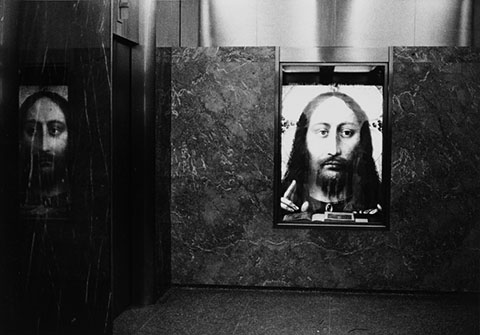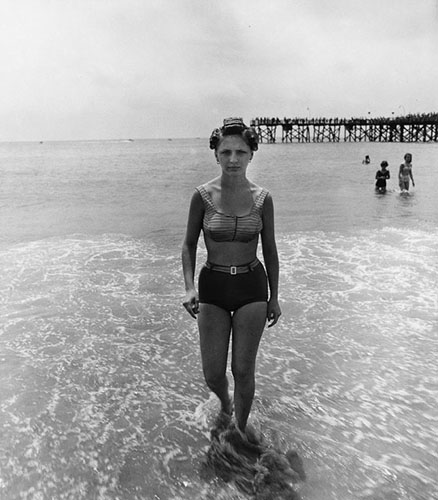 |
Diane Arbus—the photographer of freaks (whom she considered spiritual aristocrats) in a brutally and imperfectly concise description—has become one of those artists who transcend the art world. After the exhaustively hagiographical 2003 retrospective, Revelation, at SFMOMA, what more can there be to say or look at? Well, plenty, it turns out, as this show of around 30 early works and outtakes, selected by sculptor Robert Gober, proves.
So compelling is Arbus’s vision that, forty years after her work burst upon public consciousness, freaks and geeks of all body types, now freed from the norms of the early media age, will see themselves without special difficulty. (I left the 2003 SFMOMA show seeing Arbuses everywhere.)
 |
In some cases the titles alone conjure the bleak and unsentimental compassion expressed in earlier, well-known works: Blonde girl with a hot dog in the park, NYC (1971); Two girls in curlers, NYC (1963); Teenager with a baseball bat, NYC (1962); Baby in a lacy bonnet, NYC (1968); Adolescent girl in a nudist camp, New Jersey (1963); Man in hat, trunks, socks and shoes, Coney Island, NJ (1960); Woman alone in the woods at a nudist camp, New Jersey (1963); Person unknown, City Morgue, NYC (1961); Boy in a hat and sneakers at a nudist camp, Pennsylvania (1965); Sophia Loren look-alike on bed with a stuffed poodle, London England (1969); and Circus fat lady with her dog, Troubles, Maryland (1964).
Others contain visual jokes that require elucidation. Bishop at the altar, Santa Barbara CA (1964) depicts a woman in embroidered silk vestments, her eyes upraised like a moist-eyed saint in a baroque painting. Officiating in a chapel draped with embossed satin blankets, amid paintings with ruffled cloth frames (including one of Jesus with oversized head and hands), she looks like a waxwork in a diorama. Playing with reality and illusion in a similar manner is Couple dancing in front of curtains, NYC (1958-62), an image of self-possessed performers and their curtained backdrop flanked by an empty banquet hall. Muscle builder at a health club, NYC (1968) shows a posing, oiled mesomorph, surrounded by lounge furniture, dumbbells and castoff flip flops looking up at ceiling-mounted floodlights. Woman with white gloves and a fancy hat, NYC (1963) portrays its subject attired in a grotesque floral hat, black-rimmed glasses and glossy vinyl purse, scowling, but actually lost in thought. Campers as trees, Dutchess County, NY (1968), depicts three girls behind sprays of maple leaves — in shorts, pedal-pushers and slacks, respectively –standing on what looks like a photoflash-lit tennis court at night, their eyes just visible through their foliage masks.
More darkly mordant are Wax museum axe murderer, Coney Island, NYC, an image of Pasquale d’ Onofrio, “a small-time crook and house painter” (a sign informs us) who packed his murdered mistress into two suitcases which he left at the Brooklyn railroad station. In David Nemerov on his deathbed, NYC (1963), the artist’s ravaged father, lies mouth agape, eyes glittering but unfocused, freshly or imminently deceased.
In a recent New Yorker article on Van Gogh and Gauguin (Van Gogh’s Ear; January 4, 2010), Adam Gopnik discusses what he calls “moral luck,” the making of work “that no one wants in the belief that someone someday will.” In today’s resolutely careerist art world the idea that one’s audience may come only after one’s death, and be dispersed in time and space, is an alien one, but perhaps one that bears reviving. “We gawk and stare as the painters slice off their ears and down the booze or act like clowns. But we rely on them to make up for our own timidity, on their courage to dignify our caution. We are spectators in the casinos, placing bets…and we can sometimes convince ourselves that having looked is the same as having made, and that the stakes are the same for the ironic spectator and the would-be saint. But they’re not…the artist does more. He bets his life.”
“Moral courage” might be a better term than “moral luck.”
Who is the real aristocrat?
–DEWITT CHENG